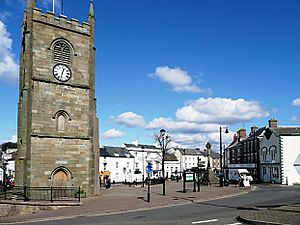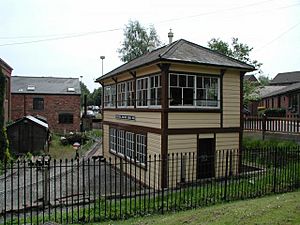Coleford, Gloucestershire facts for kids
Quick facts for kids Coleford |
|
|---|---|
 Coleford Market Place |
|
 Coleford Railway Museum |
|
| Population | 9,273 (2021 Census) |
| OS grid reference | SO5710 |
| District |
|
| Shire county | |
| Region | |
| Country | England |
| Sovereign state | United Kingdom |
| Post town | COLEFORD |
| Postcode district | GL16 |
| Dialling code | 01594 |
| Police | Gloucestershire |
| Fire | Gloucestershire |
| Ambulance | Great Western |
| EU Parliament | South West England |
| UK Parliament |
|
Coleford is a busy market town located in the western part of the Forest of Dean in Gloucestershire, England. It is about 2 kilometers (1.2 miles) east of the Welsh border and very close to the beautiful Wye Valley.
Coleford is the main administrative center for the Forest of Dean district. In 2021, the town's population was around 9,273 people. The nearby village of Baker's Hill is also part of Coleford parish.
Contents
History of Coleford
Coleford started as a small area within the larger parish of Newland. The town grew up around a ford, which is a shallow place in a river where people could cross. It was likely used to carry charcoal and iron ore.
By the mid-1300s, small villages like Coleford and Whitecliff had formed. Coleford had at least eight houses by 1349 and was called a "street" in 1364. It even had a place of worship by 1489.
The English Civil War
In 1642, during the English Civil War, a commander from the Roundhead (Parliamentary) army set up a market in Coleford. This was because the closest official market in Monmouth was controlled by the Cavalier (Royalist) army.
Coleford soon saw some fighting. In February 1643, Lord Herbert, a Royalist leader, marched through Coleford with about 2,000 soldiers. They were on their way to Gloucester. A group of Parliamentarians and local people tried to stop them.
A fight broke out, and the market-house was burned. Several officers were killed. The Royalists eventually pushed through, capturing some Parliamentarian soldiers, and continued their march to Gloucester.
Growth of the Town
After the war ended and the king returned to power in 1660 (the Restoration), Coleford was officially allowed to have a market in 1661. A new market house was built in 1679.
The town grew quickly, with about 160 houses by 1710. Many old buildings in the market place still stand today, like the Old White Hart Inn from the 1600s.
In the late 1700s and early 1800s, Coleford expanded along its other streets. Many older houses were rebuilt. The Angel Inn, which opened in the 1650s, was updated around 1800. It was once the town's main coaching inn and a place for public meetings. As Coleford became more important, the number of public houses (pubs) also increased.
The market house (town hall) was rebuilt again in 1866 to be much larger. The local church was rebuilt in 1820 but was too small. It was pulled down in 1882, but its tower was kept as a clock tower. A much bigger church, St John the Evangelist's, was built on a hill nearby. This church closed in 2016.
Coleford continued to grow throughout the 1900s with new homes and developments. In 1968, the town hall was taken down to help with traffic in the market place.
Industry in Coleford
Iron production has been important in Coleford since the Middle Ages. This process created a lot of waste material called cinders. These cinders were later reused to get more iron.
Medieval ironworks were often movable forges in the royal woodlands of the Forest of Dean. An iron furnace was working at Whitecliff in 1361. Iron was also worked in Coleford town itself.
Coalmining started north and east of Coleford in the 1500s. Limestone was also dug up at Whitecliff before the 1600s. Lime kilns at Whitecliff made lime, which was sent to Monmouthshire.
In 1798, work began on the Whitecliff Ironworks on the edge of Coleford. The furnaces there started working around 1801 or 1802. However, the quality of the coke used limited how much iron they could make.
In 1809, David Mushet, a famous expert in metals, tried to make the works more productive. But the ironworks were not making money and closed down a few years later. Today, you can still see the ruins of these old ironworks.
Transport Links
Coleford was part of a tramway that opened in 1812. This tramway connected mines in the Forest with the River Wye at Redbrook and Monmouth. It was used until the tracks east of Coleford were removed in the late 1870s.
The first railway line reached Coleford in 1875. It was a branch line from Parkend built by the Severn and Wye Railway Company. It went through Milkwall to a station on the southeast side of town.
A second railway, the Coleford Railway from Monmouth, was finished in 1883. It used parts of the old tramway route and included a short tunnel at Whitecliff. This line connected to the Severn & Wye station.
The two railways were joined in 1884. The Severn and Wye line stopped carrying passengers in 1929 and closed completely in 1967. Some railway buildings in Coleford, including a goods shed, became the Coleford Great Western Railway Museum which opened in 1988.
Today, the closest railway station for passenger trains is Lydney, about 13 kilometers (8 miles) away.
Churches in Coleford
The Anglican Holy Trinity Church is near the center of Coleford and was built in 1831. It holds services on Sundays and Wednesdays. Coleford Baptist Church and the town's Pentecostal Church also have Sunday services.
Coleford Today
Coleford managed to adapt well after the local mines closed in the 1950s. The town's location in the heart of the Forest of Dean makes it popular with walkers and cyclists. The local council works to attract more visitors.
A large factory in the town, now owned by the Japanese company Suntory, is very important. It is the only place where Ribena and Lucozade drinks are made. One old building, the former goods shed for the railway line to Monmouth, now houses the Coleford GWR Museum.
SPP Pumps Ltd, a leading pump manufacturer in Britain, also has its main UK factory in Coleford. It employs over 300 people. They make pumps for industrial use, offshore firefighting, and water systems in the UK.
Media and News
Local news and TV shows for Coleford are provided by BBC West and ITV West Country. TV signals come from the Mendip and local relay transmitters.
Local radio stations include BBC Radio Gloucestershire, Heart West, Greatest Hits Radio South West, and Dean Radio, which is a community radio station.
The town also has its own local newspaper, The Forester.
Famous People from Coleford
Many interesting people have connections to Coleford:
- Olly Alexander (born 1990), a singer and actor.
- Alan Cornwall (1898–1984), a county cricketer and schoolmaster.
- Paul Groves (living), a poet and schoolteacher who lived here for many years.
- Edna Healey (1918–2010), an author and wife of politician Denis Healey, was born in the Forest and lived in Coleford.
- Mary Howitt (1799–1888), an author who wrote over 200 books, was born here.
- Alex McLean (born 1975), an electronic musician.
- David Mushet (1772–1847), a Scottish expert in metals who developed new iron production methods, lived in Coleford for many years.
- Dennis Potter, a famous author and playwright, was born near Coleford. His works often used the local area as a setting.
- Shoo Rayner (born 1956), a children's writer and illustrator.
- Andrew Taylor (born 1951), an author.
Gallery
See also
 In Spanish: Coleford para niños
In Spanish: Coleford para niños










